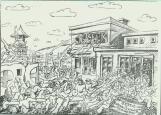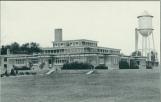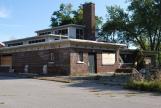1
The Cafeteria was the very first building on the site, built in 1924. Even though the Boys Training School began with only 16 boys, this building was built to serve 300 at one sitting in anticipation of the school's future role as Ontario's largest boys training school.However, this was the only dining hall on the grounds which was a problem for Camp 30 with a peak population of 800 Prisoners of War. To accommodate the POWs a meal schedule was set up that included two sittings for each meal throughout the day.
3
The cafeteria was also the headquarters for one of the most famous incidents that occured during its tenure as Camp 30 - the Battle of Bowmanville.The Battle of Bowmanvile was provoked by an order received by Lt. Colonel Taylor, then Commandant.
While the Battle has been attributed to the events following the raid on Dieppe August 19, 1942, in actuality it was a commando raid on the Island of Sark October 5, 1942. This raid resulted in the capture of five German soilders, which became the catalyst for Taylor's order. The five German prisoners had their hands tied for unknown reasons. These prisoners bolted from their captors and four were shot trying to escape.
In retaliation the Germans ordered the shackling of British and Canadian prisoners within their POW camps. Churchill then sent direction to Canada to shackle German POWs with a special interest on Camp 30 in Bowmanville since it housed the highest ranking POW officers. What followed was the Battle of Bowmanville.
6
On the morning of October 10, 1942 the prisoners were told that seventy of them would be shackled in reprisal for the manacling of Canadian prisoners in Germany. The prisoners refused to cooperate and instead barricaded themselves into buildings throughout the camp with the cafeteria being organized as the resistance headquarters. Inside the cafeteria there were 300 prisoners armed with hockey sticks and makeshift clubs. Behind this front line of resistnace were the rest of the prisoners barricaded in the buildings throughout the grounds as a reserve force. Over the next three days the Battle of Bowmanville was fought including five furious clashes fought almost entirely with bricks, hockey sticks, crockery, boots and fists. The final battle raged for more than six hours on October 12 and included Canadian guards rappelling into the cafeteria from the upper windows.By 6pm the Battle of Bowmanville was over. The Canadians had regained control of the camp. The German POWs were shackled for a short time each day and the shackles were kept quite loose so as not to limit their movement- a compromise. Canadian POWs were receiving the same type of shackling in their camps too.
German POWs have since commented on how fair the Canadians were in the battle. They came with sticks and fists just like the POWs. The Canadians were very concerned about the perception of mistreatment of the POWs by the International Red Cross which was part of the reason they did not use loaded guns during the battle. However, there was one gunfire incident that did occur toward the end of the battle. A Captain Brent, who was disliked by the POWs, was captured and shackled by them. Guards in watch towers fired warning shots to help scare the POWs away from Brent. One of the shots ricocheted off a building and struck Volkmar Konig in the leg. It is the only recorded incident of a POW being harmed by gunfire within the confines of a POW camp in Canada.
7
Caricature of The Battle of Bowmanville: October 11-13, 1942Circa 1942
Bowmanville, Ontario, Canada




